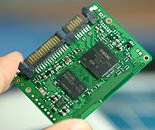malware
New Member
- Joined
- Nov 7, 2004
- Messages
- 5,422 (0.73/day)
- Location
- Bulgaria
| Processor | Intel Core 2 Quad Q6600 G0 VID: 1.2125 |
|---|---|
| Motherboard | GIGABYTE GA-P35-DS3P rev.2.0 |
| Cooling | Thermalright Ultra-120 eXtreme + Noctua NF-S12 Fan |
| Memory | 4x1 GB PQI DDR2 PC2-6400 |
| Video Card(s) | Colorful iGame Radeon HD 4890 1 GB GDDR5 |
| Storage | 2x 500 GB Seagate Barracuda 7200.11 32 MB RAID0 |
| Display(s) | BenQ G2400W 24-inch WideScreen LCD |
| Case | Cooler Master COSMOS RC-1000 (sold), Cooler Master HAF-932 (delivered) |
| Audio Device(s) | Creative X-Fi XtremeMusic + Logitech Z-5500 Digital THX |
| Power Supply | Chieftec CFT-1000G-DF 1kW |
| Software | Laptop: Lenovo 3000 N200 C2DT2310/3GB/120GB/GF7300/15.4"/Razer |
Samsung Electronics, the world leader in advanced semiconductor technology, announced today that it has begun sampling low-density, higher-performance solid state drives (SSDs) that are only 30 percent of the size of 2.5-inch SSDs and highly cost-efficient to manufacture. With the introduction of these smaller, low-capacity SSDs, Samsung now offers an attractive replacement for existing hard drives used in low-cost PCs. Available in densities of 8GB, 16GB and 32GB, the new multi-level-cell SSDs will be mass produced beginning next month.

"We've refined our manufacturing techniques and redesigned our low-density SSDs to get what the low-priced PC market is looking for in the way of improved cost, performance and availability," said Jim Elliott, Vice President, Memory Marketing, Samsung Semiconductor, Inc.
The low-density Samsung SSDs use the same high-performance SATA II controller technology as that being used on Samsung's just-introduced MLC-based 128GB SSD.
Samsung's new MLC-based SSD at 32GB capacity will read data (sequentially) at 90MB/s and write it (sequentially) at 70MB/s - performance levels much greater than low-density SSDs on the market today. The 16GB reads at 90MB/s and writes at 45MB/s, while the 8GB reads at 90MB/s and writes at 25MB/s.
Samsung incorporates four individual 16 gigabit (Gb) MLC NAND chips in its 8GB SSD, as well as four dual-die packages and four quad-die packages of 16Gb NAND for its 16GB and 32GB SSDs respectively. Furthermore, by including a 32MB DRAM as the buffer and four-channel system for the new low-density SSDs, these solutions are better suited for high-speed reading environments.
Samsung has expanded its SSD market offerings since it introduced its first SSD in 2006 in 16GB and 32GB capacities targeted at the Ultra Mobile PC market. This was followed by the announcement of the 64GB SSD in 2007, a 128GB SSD in 2008, and sampling of a 256GB SSD in the second half of 2008.
With increased sales of low-cost PCs and recent efforts by most major PC manufacturers to develop their own low-cost PC offerings, the market for lower density SSDs has been experiencing explosive growth. By unit sales, the low-density SSD market is expected to increase annually by 57% until 2011, with SSDs for low-priced PCs being the main driver of market demand.
View at TechPowerUp Main Site

"We've refined our manufacturing techniques and redesigned our low-density SSDs to get what the low-priced PC market is looking for in the way of improved cost, performance and availability," said Jim Elliott, Vice President, Memory Marketing, Samsung Semiconductor, Inc.
The low-density Samsung SSDs use the same high-performance SATA II controller technology as that being used on Samsung's just-introduced MLC-based 128GB SSD.
Samsung's new MLC-based SSD at 32GB capacity will read data (sequentially) at 90MB/s and write it (sequentially) at 70MB/s - performance levels much greater than low-density SSDs on the market today. The 16GB reads at 90MB/s and writes at 45MB/s, while the 8GB reads at 90MB/s and writes at 25MB/s.
Samsung incorporates four individual 16 gigabit (Gb) MLC NAND chips in its 8GB SSD, as well as four dual-die packages and four quad-die packages of 16Gb NAND for its 16GB and 32GB SSDs respectively. Furthermore, by including a 32MB DRAM as the buffer and four-channel system for the new low-density SSDs, these solutions are better suited for high-speed reading environments.
Samsung has expanded its SSD market offerings since it introduced its first SSD in 2006 in 16GB and 32GB capacities targeted at the Ultra Mobile PC market. This was followed by the announcement of the 64GB SSD in 2007, a 128GB SSD in 2008, and sampling of a 256GB SSD in the second half of 2008.
With increased sales of low-cost PCs and recent efforts by most major PC manufacturers to develop their own low-cost PC offerings, the market for lower density SSDs has been experiencing explosive growth. By unit sales, the low-density SSD market is expected to increase annually by 57% until 2011, with SSDs for low-priced PCs being the main driver of market demand.
View at TechPowerUp Main Site





 .
.
